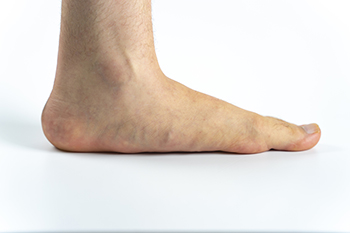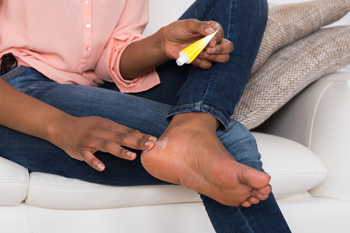Items filtered by date: October 2022
How to Wash Your Feet if You Have Diabetes

For diabetics, foot health care is an important part of daily life. Problems, such as diabetic neuropathy and peripheral artery disease, that stem from long-term high blood sugar levels can make a daily foot care regimen essential. If sores, wounds, and cuts are not treated, they can develop ulcers that could, over time, lead to more serious problems. One major way a diabetic can ward off potential foot problems is to carefully wash and dry the feet each day. First, use warm, not hot, water. Using mild soap, wash every part of the foot, including the bottom and between the toes. Next, gently pat the feet dry. Avoid rubbing the skin. Finally, carefully dry between each toe. If you have difficulty reaching your feet or performing this task, it is a good idea to ask a family member or health aide for help. Then apply lotion to keep the skin from cracking and to help soften calluses, but be careful to avoid putting lotion between the toes. If you have diabetes-related foot problems, it is wise to seek regular checkups from a podiatrist who is trained to deal with the effects of this disease.
Diabetic foot care is important in preventing foot ailments such as ulcers. If you are suffering from diabetes or have any other concerns about your feet, contact one of our podiatrists from Itasca Foot & Ankle. Our doctors can provide the care you need to keep you pain-free and on your feet.
Diabetic Foot Care
Diabetes affects millions of people every year. The condition can damage blood vessels in many parts of the body, especially the feet. Because of this, taking care of your feet is essential if you have diabetes, and having a podiatrist help monitor your foot health is highly recommended.
The Importance of Caring for Your Feet
- Routinely inspect your feet for bruises or sores.
- Wear socks that fit your feet comfortably.
- Wear comfortable shoes that provide adequate support.
Patients with diabetes should have their doctor monitor their blood levels, as blood sugar levels play such a huge role in diabetic care. Monitoring these levels on a regular basis is highly advised.
It is always best to inform your healthcare professional of any concerns you may have regarding your feet, especially for diabetic patients. Early treatment and routine foot examinations are keys to maintaining proper health, especially because severe complications can arise if proper treatment is not applied.
If you have any questions please feel free to contact our offices located in Itasca and Hoffman Estates, IL . We offer the newest diagnostic and treatment technologies for all your foot and ankle needs.
Are You Suffering From Ingrown Toenails?
Causes of Flat Feet

Flat feet are a common condition of the foot that does not have an arch or some elevation in the middle of the forefoot. They can develop in people of all ages and genders. Flat feet can result in tired feet as well as foot and ankle pain. Feet can swell and the Achilles tendon can get damaged from excessive pressure on the foot. Bunions can also form. Flat feet can be a result of ill-fitting shoes, wearing the wrong types of shoes for too long, swollen feet, gait changes, genetics, obesity, and certain medical conditions like rheumatoid arthritis. If you put your feet on the ground and they are flush with the floor, you likely have flat feet. If you have foot pain or want to prevent problems that can occur from flat feet, see a podiatrist who can help with shoe suggestions, orthotics, and other treatment options.
Flatfoot is a condition many people suffer from. If you have flat feet, contact one of our podiatrists from Itasca Foot & Ankle. Our doctors will treat your foot and ankle needs.
What Are Flat Feet?
Flatfoot is a condition in which the arch of the foot is depressed and the sole of the foot is almost completely in contact with the ground. About 20-30% of the population generally has flat feet because their arches never formed during growth.
Conditions & Problems:
Having flat feet makes it difficult to run or walk because of the stress placed on the ankles.
Alignment – The general alignment of your legs can be disrupted, because the ankles move inward which can cause major discomfort.
Knees – If you have complications with your knees, flat feet can be a contributor to arthritis in that area.
Symptoms
- Pain around the heel or arch area
- Trouble standing on the tip toe
- Swelling around the inside of the ankle
- Flat look to one or both feet
- Having your shoes feel uneven when worn
Treatment
If you are experiencing pain and stress on the foot you may weaken the posterior tibial tendon, which runs around the inside of the ankle.
If you have any questions please feel free to contact our offices located in Itasca and Hoffman Estates, IL . We offer the newest diagnostic and treatment technologies for all your foot and ankle needs.
Signs of Cracked Heels

One of the many unsightly and unattractive conditions of the feet is known as cracked heels. Also known as heel fissures or split heel, this condition occurs when the skin on the heel becomes exceedingly dry. There are several signs of cracked heels that you can be on the lookout for. First, the most obvious sign of cracked heels is a developing callus on the heel that can be either a shade of yellow or brown. If the condition is relatively new, you might notice small cracks in the hardened skin callus. However, if this condition is older and has not been treated for a long period of time, then there may be deeper cracks in the callus. These deeper cracks might even bleed in severe cases, inviting infection. If you notice any of these signs, or you believe that you might have cracked heels, do not hesitate to schedule an appointment with a podiatrist today.
Cracked heels are unsightly and can cause further damage to your shoes and feet. If you have any concerns, contact one of our podiatrists from Itasca Foot & Ankle. Our doctors can provide the care you need to keep you pain-free and on your feet.
Cracked Heels
Cracked heels appear unappealing and can make it harder for you walk around in sandals. Aside from looking unpleasant, cracked heels can also tear stockings, socks, and wear out your shoes. There are several methods to help restore a cracked heel and prevent further damage.
How Do You Get Them?
Dry skin is the number one culprit in creating cracked heels. Many athletes, walkers, joggers, and even swimmers suffer from cracked heels. Age and skin oil production play a role to getting cracked heels as well.
Promote Healing
Over the counter medicines can help, especially for those that need instant relief or who suffer from chronic dry feet.
Wear Socks – Wearing socks with medicated creams helps lock in moisture.
Moisturizers – Applying both day and night will help alleviate dryness which causes cracking.
Pumice Stones – These exfoliate and remove dead skin, which allows for smoother moisturizer application and better absorption into the skin.
Change in Diet
Eating healthy with a well-balanced diet will give the skin a fresh and radiant look. Your body responds to the kinds of food you ingest. Omega-3 fatty acids and zinc supplements can also revitalize skin tissue.
Most importantly, seek professional help if unsure how to proceed in treating cracked heels. A podiatrist will help you with any questions or information needed.
If you have any questions, please feel free to contact our offices located in Itasca and Hoffman Estates, IL . We offer the newest diagnostic and treatment technologies for all your foot care needs.
Risks and Prevention of Heel Spurs

A heel spur is a bony protrusion on the underside of the calcaneus or heel bone. A heel spur can extend as much as half an inch from the bone. Some heel spurs are painless, but others can induce chronic pain that is sometimes associated with plantar fasciitis. These spurs are more common among athletes who do a lot of jumping and running. Risks for the development of heel spurs include running or jogging on hard surfaces, gait abnormalities that place excessive stress on the calcaneus, and being overweight. In addition, poorly fitted shoes that lack sufficient arch support can increase the risk of heel spurs. Just the process of aging can be a risk factor as the result of thinning fat pads in the heels. Other risks are engaging in short bursts of activity, spending an excessive amount of time on your feet, and having flat feet or high arches. Prevention tips include wearing well-fitting shoes with ample heel support and shock-absorbing soles. In some cases, custom orthotics may be the answer. For details on dealing with heel spurs and information on orthotics, please consult a podiatrist.
Heel spurs can be incredibly painful and sometimes may make you unable to participate in physical activities. To get medical care for your heel spurs, contact one of our podiatrists from Itasca Foot & Ankle. Our doctors will do everything possible to treat your condition.
Heels Spurs
Heel spurs are formed by calcium deposits on the back of the foot where the heel is. This can also be caused by small fragments of bone breaking off one section of the foot, attaching onto the back of the foot. Heel spurs can also be bone growth on the back of the foot and may grow in the direction of the arch of the foot.
Older individuals usually suffer from heel spurs and pain sometimes intensifies with age. One of the main condition's spurs are related to is plantar fasciitis.
Pain
The pain associated with spurs is often because of weight placed on the feet. When someone is walking, their entire weight is concentrated on the feet. Bone spurs then have the tendency to affect other bones and tissues around the foot. As the pain continues, the feet will become tender and sensitive over time.
Treatments
There are many ways to treat heel spurs. If one is suffering from heel spurs in conjunction with pain, there are several methods for healing. Medication, surgery, and herbal care are some options.
If you have any questions feel free to contact our offices located in Itasca and Hoffman Estates, IL . We offer the latest in diagnostic and treatment technology to meet your needs.
